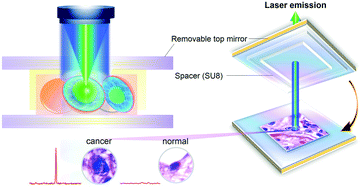Our official English website, www.x-mol.net, welcomes your
feedback! (Note: you will need to create a separate account there.)
A robust tissue laser platform for analysis of formalin-fixed paraffin-embedded biopsies†
Lab on a Chip ( IF 6.1 ) Pub Date : 2018-03-01 00:00:00 , DOI: 10.1039/c8lc00084k Yu-Cheng Chen 1, 2, 3, 4 , Qiushu Chen 1, 2, 3, 4 , Xiaoqin Wu 1, 2, 3, 4 , Xiaotian Tan 1, 2, 3, 4 , Juanhong Wang 5, 6, 7, 8 , Xudong Fan 1, 2, 3, 4
Lab on a Chip ( IF 6.1 ) Pub Date : 2018-03-01 00:00:00 , DOI: 10.1039/c8lc00084k Yu-Cheng Chen 1, 2, 3, 4 , Qiushu Chen 1, 2, 3, 4 , Xiaoqin Wu 1, 2, 3, 4 , Xiaotian Tan 1, 2, 3, 4 , Juanhong Wang 5, 6, 7, 8 , Xudong Fan 1, 2, 3, 4
Affiliation

|
Laser emission-based detection and imaging technology has attracted significant interest in biomedical research due to its high sensitivity, narrow linewidth, and superior spectral and spatial resolution. Recent advances have further revealed the potential to use laser emission to investigate chromatin dynamics, as well as to diagnose cancer tissues based on nuclear biomarkers. To move the laser emission based detection technology a step further towards practical use, in this work, we developed a highly robust tissue laser platform by microfabricating an SU8 spacer with a fixed height on the top mirror of the Fabry–Pérot (FP) cavity, which allows generation of reproducible and stable lasing results regardless of tissue thickness. Then we applied this platform to achieve lasing emission from formalin-fixed, paraffin-embedded (FFPE) lung tissues, which account for an overwhelming fraction of tissues collected for research and clinical use worldwide. We further showed that the cancer and normal FFPE lung tissues can be distinguished by their respective lasing thresholds. Two different tissue thicknesses (10 μm and 5 μm) commonly used in pathological labs were explored. Finally, we tested three additional types of tissues (colon, stomach, and breast) that were prepared independently by lab technicians in a pathology lab in China and shipped to the US in order to validate the general applicability and practicality of the laser emission-based technology as well as the corresponding sample preparation protocol and the tissue laser platform. Our work will not only vastly broaden the applications of laser emission-based detection/imaging technology but also help translate it from the laboratory to an automated system for clinical practice that may eventually benefit biomedicine and biological research.
更新日期:2018-03-01











































 京公网安备 11010802027423号
京公网安备 11010802027423号